ALLERGENIC AND ANNUAL POLLEN INTEGRAL
Data aggiornamento scheda: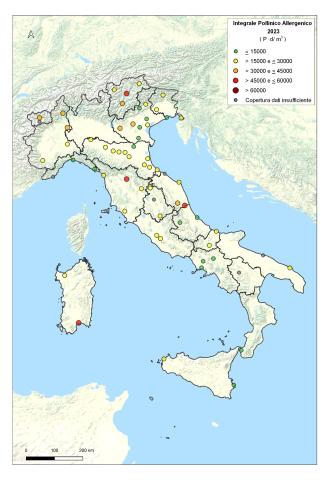
The indicator Allergenic and Annual Pollen Integral considers two cumulative metrics: the Annual Pollen Integral (IPAn) and the Allergenic Pollen Integral (IPA), which quantify the total amount of airborne pollen detected over the course of a year in the locations where monitoring stations are installed. Both IPAn and IPA are subject to potentially significant local interannual variability, primarily driven by fluctuations in seasonal meteorological and climatic conditions. These are cumulative quantitative indicators and, as such, do not provide information on the temporal distribution of airborne pollen throughout the year.
AMBIENT AIR QUALITY: BENZO(A)PYRENE IN PM10
Data aggiornamento scheda: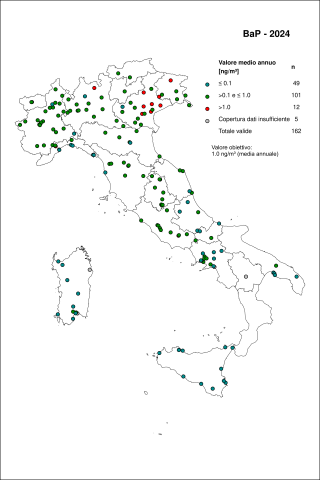
The indicator is based on atmospheric concentration data of benzo(a)pyrene measured in 2023 at monitoring stations distributed across the national territory, collected and archived by ISPRA in the InfoAria database, in accordance with Directive 2008/50/EC (and its national transposition, Legislative Decree 155/2010) and Commission Implementing Decision 2011/850/EU. A total of 164 monitoring stations measured and reported B(a)P data. Among these, 159 provided time series with sufficient temporal coverage for the verification of reference values. Exceedances of the target value were recorded at 17 stations, corresponding to 10.7% of the cases.
AMBIENT AIR QUALITY: NITROGEN DIOXIDE (NO₂)
Data aggiornamento scheda:
The indicator is based on nitrogen dioxide (NO₂) concentration data measured in 2023 at monitoring stations distributed across the national territory, collected and archived by ISPRA in the InfoAria database, in accordance with Directive 2008/50/EC (and its national transposition, Legislative Decree 155/2010) and Commission Implementing Decision 2011/850/EU. A total of 630 monitoring stations measured and reported NO₂ data. Of these, 600 provided data series with sufficient temporal coverage to verify compliance with reference values.
The hourly limit value was respected at all stations: no exceedance of 200 µg/m³ (hourly average) for more than 18 occasions was recorded. The WHO reference value, which does not permit any exceedances of 200 µg/m³, was exceeded at 8 stations (1.3% of those with sufficient data coverage). The annual limit value, set at 40 µg/m³ (annual mean), was exceeded at 13 stations (2.2%). The WHO guideline value for long-term human health protection, set at 10 µg/m³ as an annual mean, was exceeded at 450 stations (75.0%).
AMBIENT AIR QUALITY: PARTICULATE MATTER (PM10)
Data aggiornamento scheda: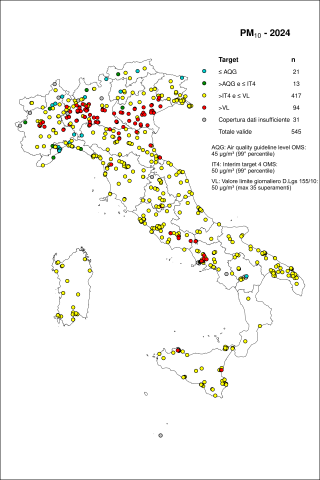
The indicator is based on atmospheric PM10 concentration data measured in 2023 at monitoring stations distributed across the national territory, collected and archived by ISPRA in the InfoAria database, in accordance with Directive 2008/50/EC (and its national transposition, Legislative Decree 155/2010) and Commission Implementing Decision 2011/850/EU. A total of 573 monitoring stations reported PM10 data. Of these, 541 provided time series with sufficient temporal coverage for validation against reference thresholds. No exceedances of the annual limit value were recorded, whereas the daily limit value was exceeded at 63 stations (equivalent to 12% of cases). Furthermore, the vast majority of monitoring stations reported exceedances of both the WHO annual reference level (91% of cases) and the daily reference level (84% of cases).
AMBIENT AIR QUALITY: PARTICULATE MATTER (PM2.5)
Data aggiornamento scheda:
The indicator is based on atmospheric PM2.5 concentration data measured in 2023 at monitoring stations distributed across the national territory, collected and archived by ISPRA in the InfoAria database, in accordance with Directive 2008/50/EC (and its national transposition, Legislative Decree 155/2010, as amended) and Commission Implementing Decision 2011/850/EU.
A total of 334 monitoring stations measured and reported PM2.5 data. Of these, 310 provided data series with sufficient temporal coverage to assess compliance with reference values. The annual limit value for PM2.5 (25 µg/m³) was met at all stations except one, corresponding to 0.3% of cases. However, the majority of monitoring stations (99.7%) exceeded the updated WHO annual reference value of 5 µg/m³ (previously set at 10 µg/m³).
AMBIENT AIR QUALITY: TROPOSPHERIC OZONE (O₃)
Data aggiornamento scheda: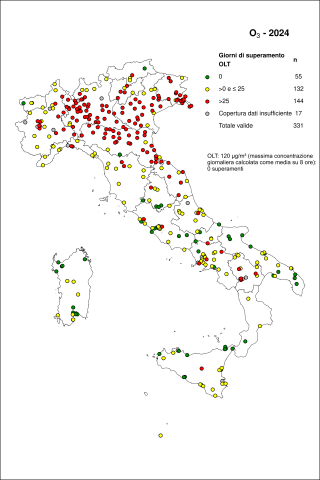
The indicator is based on atmospheric ozone (O₃) concentration data measured in 2023 at monitoring stations distributed across the national territory, collected and archived by ISPRA in the InfoAria database, in accordance with Directive 2008/50/EC (and its national transposition, Legislative Decree 155/2010) and Commission Implementing Decision 2011/850/EU. A total of 348 monitoring stations measured and reported ozone data. Of these, 326 provided data series with sufficient temporal coverage to assess compliance with threshold values and the long-term objective (LTO) for the protection of human health.
Suburban, rural, and background rural stations meeting the minimum data coverage required for the calculation of the long-term objective for vegetation protection (AOT40v) numbered 146. The LTO for human health was exceeded at 88.1% of stations. In 43.9% of the stations, this LTO was exceeded for more than 25 days.
The information threshold for health protection was exceeded at 34% of stations, while the alert threshold was exceeded at only 2 stations. The WHO reference level—set at 100 µg/m³ as the 99th percentile of daily maximum 8-hour mean concentrations—was exceeded at 313 stations (96% of those with sufficient data coverage). The long-term objective for vegetation protection (AOT40v) was exceeded at 93.2% of the stations.
POLLEN SEASON
Data aggiornamento scheda: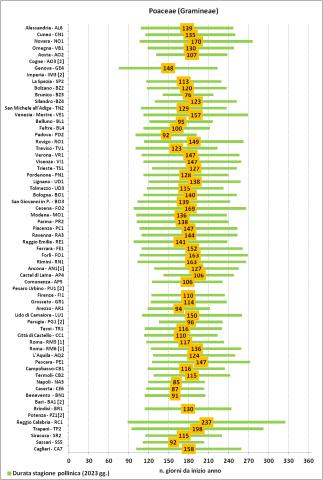
The indicator describes the timing of the pollination period for a specific botanical family over the course of the year. The start and end dates, as well as the duration of the pollen season for a given family, vary by location due to the high sensitivity of pollination to local meteorological and climatic conditions. It is important to note that the duration of the pollen season is not directly correlated with the total amount of airborne pollen. A comparative analysis of the start and end dates of the monitored families' pollination can reveal the presence of airborne pollen, in certain locations, even during the months of January and December.